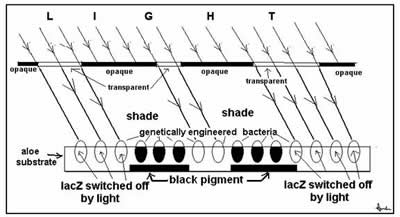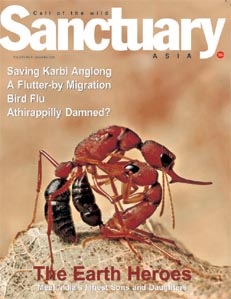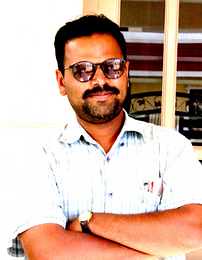Photo film does the comeback with biological film
By - S.Ananthanarayanan
Photographers of wildlife will feel good that the next improvement in the quality of pictures may come thanks to living things – bacteria. This is in the form of film based on light-sensitive bacteria helping photo-film regain the place it once had till digital photography took the lead.
In the early days of digital photography, it was still believed that despite convenience and easy processing of the digital picture, in quality and speed the photo film was superior. But rapid improvement of digital photography has proved this wrong and the digital camera now matches the chemical film camera in every respect.
The Chemical film
This was based on crystals of silver iodide, or similar substances, suspended in celluloid film. The silver-iodine combination is tenuous and even photons of light can break the bond, to leave metallic silver behind. When light fell on a film, a ‘latent' image, of metallic silver deposit was left where the light was strong. The parts of the film where light had not fallen were washed away in ‘developing and fixing' and the opacity that remained where the light had fallen was the ‘negative'.
In colour photography, there are three kinds of photo-materials, each sensitive to red, green or blue light. With the three kinds spread over layers, all shades of colours could be captured, according to the numbers of the different photo-materials affected.
The limit to how sharp the images could be was defined by how small the crystals of the photo-material could be. The best films, with the finest crystals, had a grain size between 8 and 11 microns (a micron is a thousandth of a millimeter). We can readily see that detail finer than about the grain size could not be captured.
Digital photography
In the place of photo-sensitive crystals, usually randomly distributed, the digital camera screen uses an array of photo-sensitive electronic elements. The output from each element, during an exposure, is a record of the intensity of light falling on that element. An electronic circuit can then record the output of all the elements in the array and this list of numbers becomes the ‘image'. For display, the numbers are converted to optical output from light emitting elements in a display screen. Or the numbers could be passed to a printer, or even to expose a photographic film.
We can imagine that electronic imaging and display elements would be cumbersome and were not likely to match the delicacy possible with crystals. It is the marvel of advances in micro circuitry that ‘pixels' or sensitive elements in unit area of a digital screen, have grown so much that the equivalent of a grain size of nearly 5 microns has become possible. Photographers who use both photo-film and digital photography now find little to choose between the two in quality of output. And digital photography has obvious advantages of ease of handling and manipulation.
Enter biological film
Christopher Voigt and colleagues, at the California Institute of Technology have created a light sensitive mat consisting of a genetically modified version of the bacterium e-coli. The scientists first used a strain of the bacterium that contains a gene called lacZ, which makes it capable of producing a black pigment. The bacterium was then made light sensing by adding a gene from a light sensitive organism called cyanobacterium, using methods of genetic engineering.
The components of the bacterium were so aligned that the photoreceptor interfered with the expression of lacZ and prevented the black pigment from being produced. A lawn of these bacteria grown on a base of wax could then hold an image of a light pattern, by keeping illuminated portions light, while the dark portions turned black!

The e-coli bacterium is about 2 microns long and less than a micron across. This enables much finer sensitivity to detail and the effective pixels count is about 10 times better than good digital photographs. When the biofilm becomes commercially available it may bring back the older kind of photography with sharper detail and better contrast!
[the writer can be contacted at simplescience@gmail.com]

Linux distros for older hardware
Friday February 24, 2006 (03:01 PM GMT)
By: J
oe 'Zonker' BrockmeierMicrosoft lately has been challenging Linux's suitability for older hardware, so it seems like a good time to look at Linux distributions that can run on older machines. I took six distributions for a test run on an old machine, and also tried software that turns old hardware into a thin client. The bottom line: Linux is still quite suitable for older hardware. It might not turn your aging PC into a powerhouse, but it will extend its lifespan considerably.
For these tests, I dug out Igor, an old PC that had been collecting dust in my closet. Igor is a Pentium II 233MHz machine with 64MB of RAM, an 8x CD-ROM drive, a 3GB hard drive, and an integrated ATI 3D Rage Pro video card with 4MB of video RAM. You can run Linux on older and slower machines, but this is the most under-powered machine I had available.
Next, I selected a handful of lightweight Linux distributions that looked promising, and started downloading. The distributions ranged from popular "mainstream" distros such as Slackware and Debian to distros that are specifically developed for lightweight machines, such as Damn Small Linux (DSL).
Full Story
SanDisk higher capacity Extreme III cards
SanDisk Doubles Capacity Of Its SanDisk Extreme III Cards - Its Fastest Digital Film Cards For Professional Photographers8-Gigabyte Extreme III Cards Offer Speed, Performance and Capacities That Are Ideal For Digital SLRsORLANDO, FL, Feb. 26, 2006 - SanDisk® Corporation (NASDAQ:SNDK) today announced the addition of new card capacities to its Extreme III line of flash cards for professional digital cameras that are double the highest capacity points currently available. The new cards include the 8-gigabyte (GB)1 CompactFlash®, 2GB SD™ and 2GB Memory Stick PRO Duo™ digital film cards. The announcement was made at the Photo Marketing Association trade show.
SanDisk Extreme III CompactFlash and SD cards have minimum write and read speeds of 20 megabytes per second (MB/sec.) Memory Stick PRO Duo cards have minimum write and read speeds of 18 MB/sec. 2 The SanDisk Extreme III cards, which range in capacity between 1- and 8GB are among the world’s fastest working cards in many of today’s leading digital single lens reflex (SLR) cameras. 3
SanDisk Extreme III cards are targeted primarily at professional photographers who require high-speed flash memory storage cards for their high-performance digital SLRs. The cards will start shipping worldwide in March to photo retailers.
“Many photographers are wary of using cards that are larger than 1GB because they don’t want to ‘put all their eggs in one basket,’ so to speak,” said Jonathan Torgovnik, contract photographer for Newsweek magazine. “While that’s a valid concern, I shoot RAW so using large capacity cards is a must. It also lets me concentrate on taking pictures rather than worrying about a pocket full of lower capacity cards that can easily be lost or misplaced.”
Tanya Chuang, SanDisk retail product marketing manager, said, “The SanDisk Extreme III line offers professional photographers an ideal combination of reliability, performance and capacity to match their shooting and workflow requirements. These are the highest performance cards you can get in CompactFlash, Memory Stick PRO Duo and SD card formats.”
SanDisk Extreme III cards use SanDisk-developed ESP (Enhanced Super-Parallel Processing) technology that combines advanced NAND flash memory chips and controller designs, 32-bit RISC processing and leading edge algorithms for an architecture that streamlines every aspect of read and write data transfer operations. In addition, SanDisk works closely with major camera manufacturers to ensure speed and compatibility. The ESP architecture effectively removes the card as the bottleneck in data storage applications.
SanDisk Extreme III cards are designed to withstand the industry’s widest guaranteed operating temperature range from a freezing minus 13F (minus 25C) to a scorching 185F (plus 85C). The cards also include RescuePRO® software that allows photographers to easily recover accidentally deleted images, lost digital images or data.
Full StorySanDisk Page
Linux Invades Hollywood
Ten years ago, Linux was a student's hobby. Now it's becoming the film industry's operating system of choiceBy Robin Rowe Shrek was the first major motion picture created primarily using Linux. It won't be the last. Linux is rapidly becoming the professional animator's operating system (OS) of choice, not just at DreamWorks SKG, which produced Shrek, but at top production studios in Hollywood, the Bay Area, and London. An OS that started 10 years ago as a Finnish college student's personal hobby-not even a university research project-is invading film industry servers, renderfarms, and workstations.
Film animators are now using Linux versions of Alias|Wavefront's Maya, No thing Real's Shake, Side Effects' Houdini, and Pixar's RenderMan-the leading commercial applications for animation, compositing, special effects, and rendering. Internally, the studios have ported millions of lines of proprietary code to Linux and are writing more. How did Linux go from a hobby to a professional graphics environment?
It was August 1991 when Linus Torvalds posted this innocent USENIX message about what would later be named Linux: "I'm doing a (free) operating system (just a hobby, won't be big and professional like gnu) for 386 (486) AT clones."
At that time, the IBM PC was 10 years old, Windows 3.0 was just emerging, and most PC users were still running MS-DOS. The Macintosh OS, which just about everyone agreed was superior to Windows at the time, would soon lose market share to Windows, a cheaper rival that came late to the party but ran on more systems and had broader support. But whether they were Macs or Windows-based systems, PCs were inconsequential to the film industry 10 years ago. Serious graphics work was done on Unix workstations, especially those from SGI.
Indeed, SGI servers and workstations dominated the movie industry because they were good at two things: crunching numbers (for rendering animation), and displaying high-resolution graphics images quickly on the screen. Hollywood may have represented only about 10 percent of SGI's sales, but the company listened to the visual effects community and met its needs, largely because the demands on computers in movie production made it an ideal proving ground for advanced features and applications.
Full Story
What is Everplay ?
EVERPLAY contains a set of standards for the consumer imaging and electronics industry, aimed to provide products that are designed to satisfy consumers desire to protect their image assets for generations and provide interoperability across a variety of devices.
Since Photokina 2004, when its formation was announced, the EVERPLAY founders have worked to define the standard, which was initially called the Picture Archiving and Sharing Standard, abbreviated as "PASS" at that time. In concurrence with the completion of the PASS standard and the start of licensing, the new name "EVERPLAY" shall be used as an interchangeable name for the spec.
The EVERPLAY standard has defined the rules for preserving photographic images and associated meta data, so that they can be reproduced and enjoyed even through the transition to future storage media and technologies.
EVERPLAY enables evolution of an individual company's system/products while at the same time sustaining interoperability and preserving the photographic images.
The EVERPLAY standard shall work by the scheme below, where index and album files, written in extensible XML, are simply added to image data files.

 Everply Official Site
Everply Official Site
Capturing wildlife on lens
Deepa Mohan
At 25, Bangalore-based Kalyan Varma has vied with some of India's top wildlife photographers and within a year of taking up wildlife photography, he won the ABN Amro Wildlife Photographer of the Year award. His prize-winning picture is of worker ants attacking the queen ant. It was featured on the cover of the December 2005 issue of Sanctuary, the wildlife magazine. He also won two special mentions for two of the other three photographs that he had submitted.

Kalyan Varma is an IT professional who decided to quit from a successful IT company took a course for budding naturalists and was bitten for life by the wildlife bug. He now sees IT as a means of keeping up with his passion. At the age of 22, he won a Superstar Award in the dot com, and was one of 12 people worldwide to win the award that year.
From 2002 to 2004 Kalyan started going on trips to various wildlife reserves. He had very basic equipment camera-wise, but from taking abstract pictures and street shots, he tried his hand at wildlife photography. In October 2004 he quit his IT job. He had saved some money, and decided to take a break while he figured out what to do next.
He decided to take the naturalist course conducted by C R Sarath, the chief naturalist of Jungle Lodges and Resorts. After the course, he was offered the job of naturalist at the JLR resort at B R Hills in K Gudi. He was initially hesitant and finally agreed. At the same time he started his serious wildlife photography with a Rs 5,000 lens !
The flora and fauna of B R Hills cast their spell on him and the weeks stretched into months, as slowly his love for wildlife and their documentation took over his life. Realising that he had a rare opportunity of taking great photographs, he decided to invest about Rs one lakh in lenses - macro lens, wide-angle lens and a zoom lens.
"Good equipment really matters in wildlife photography", he says, " as you are likely to get excellent photographs even under adverse conditions." He also attributes success to his being a good naturalist - knowing the behaviour of animals would helps one to plan one's photography better. He also is strong on the necessity of "wildlife ethics." One has to walk a fine line between documentation and disturbance, he feels.
Soon the necessity of making enough money to support this passion forced him to decide to come back to the city. He started his own company, SecuPrise, with a partner, who is also a passionate photographer and had also made his money in IT startups. Now, Kalyan shuttles between Bangalore and the forests, as each mistress calls him with urgent demands. He posted his pictures on the web, and in a short time, he had thousands of visitors on his website, and to his blog (
http://kalyan.livejournal.com/) - a huge fan following consisting of old and new friends, acquaintances and strangers.
After winning the ABN Amro Wildlife Photographer of the Year award, Kalyan’s ambition is now to enter the BBC Wildlife Photography competition. For him, the priority might be the animal being endangered. His present dream is to shoot the clouded leopard.
He also wants to educate others about the richness of wildlife in India by bringing his photographs to their drawing rooms. He wants to reach out to people who don't go to the jungles, and show them what's out there.
Story


 Vijay Barve
Vijay Barve














